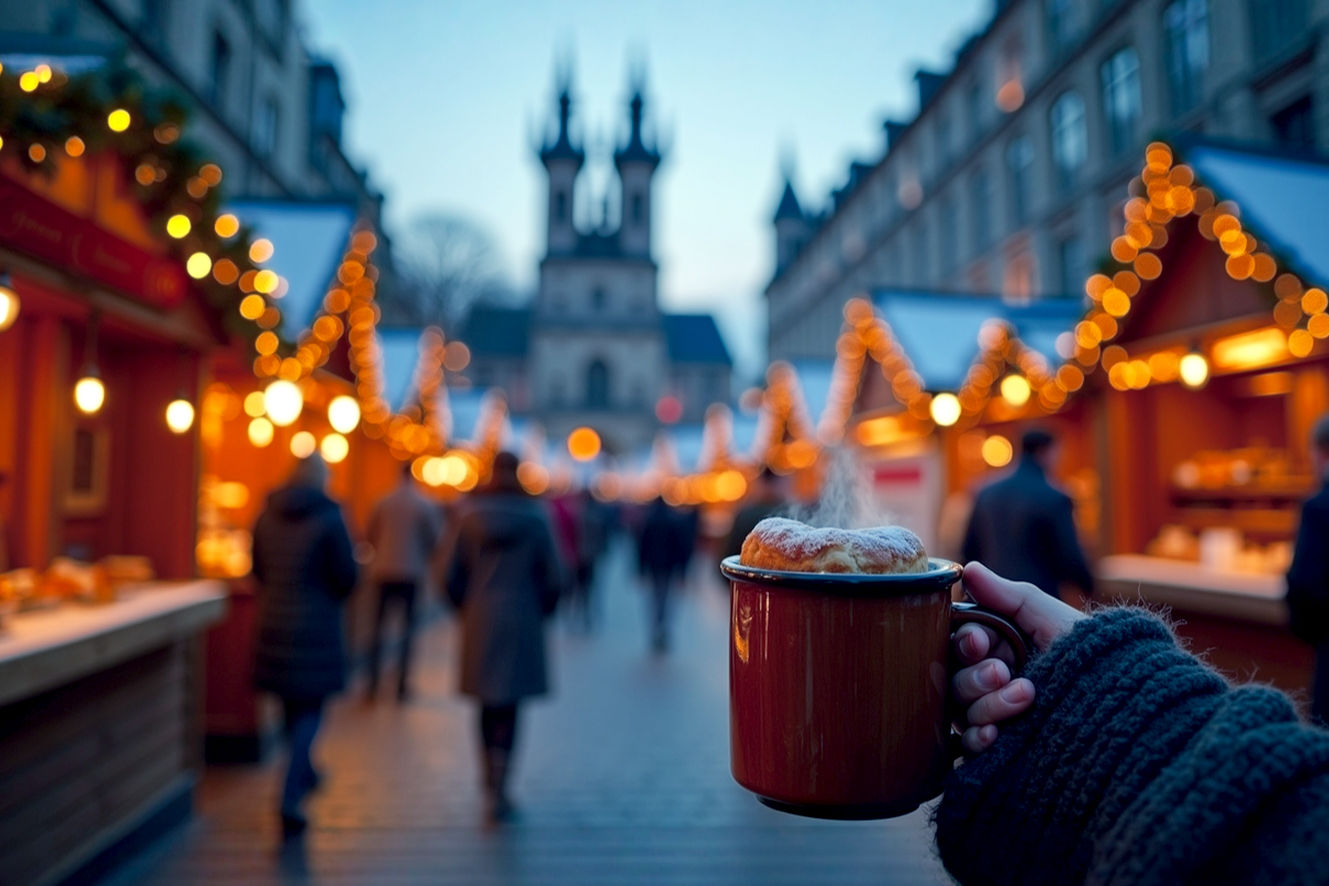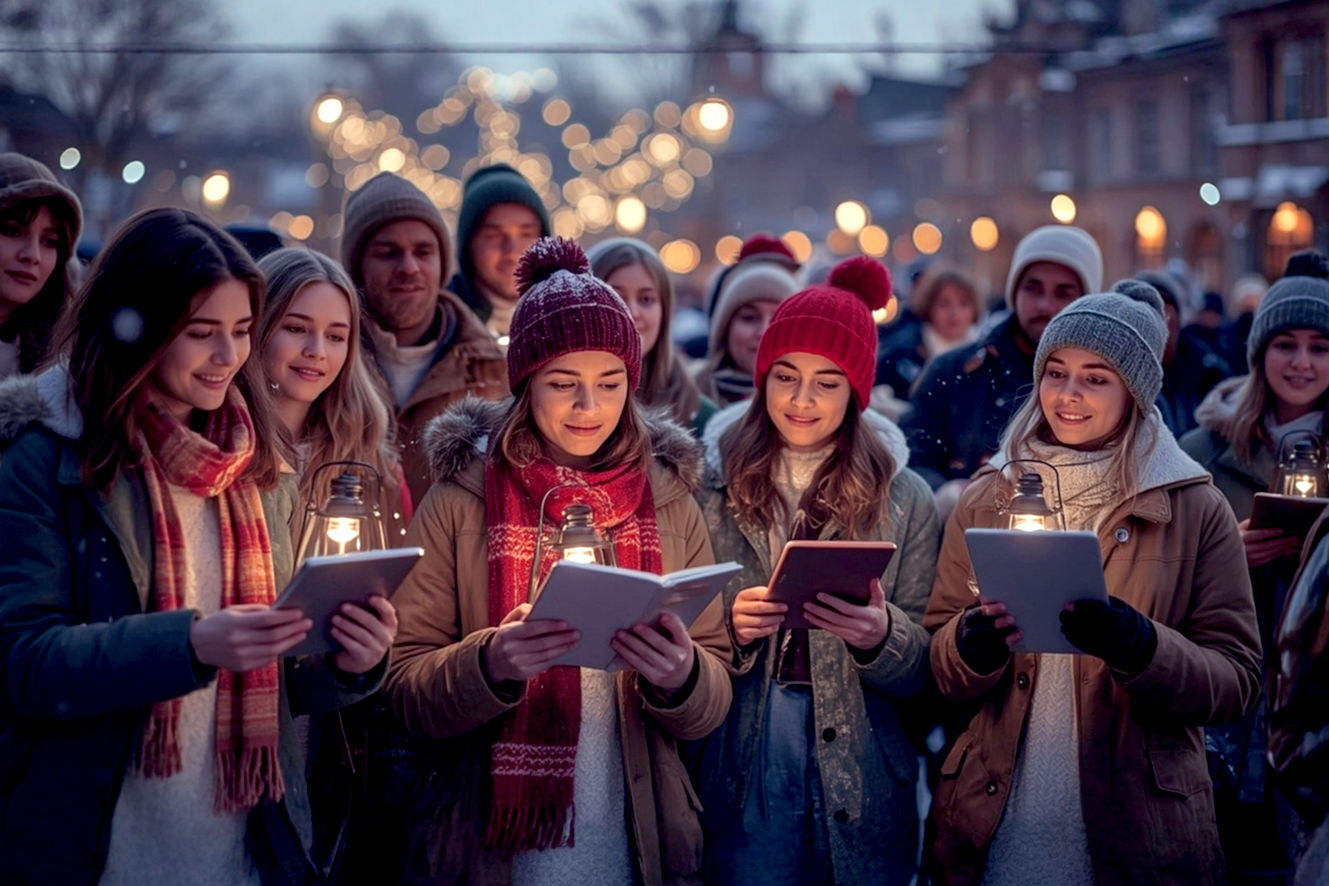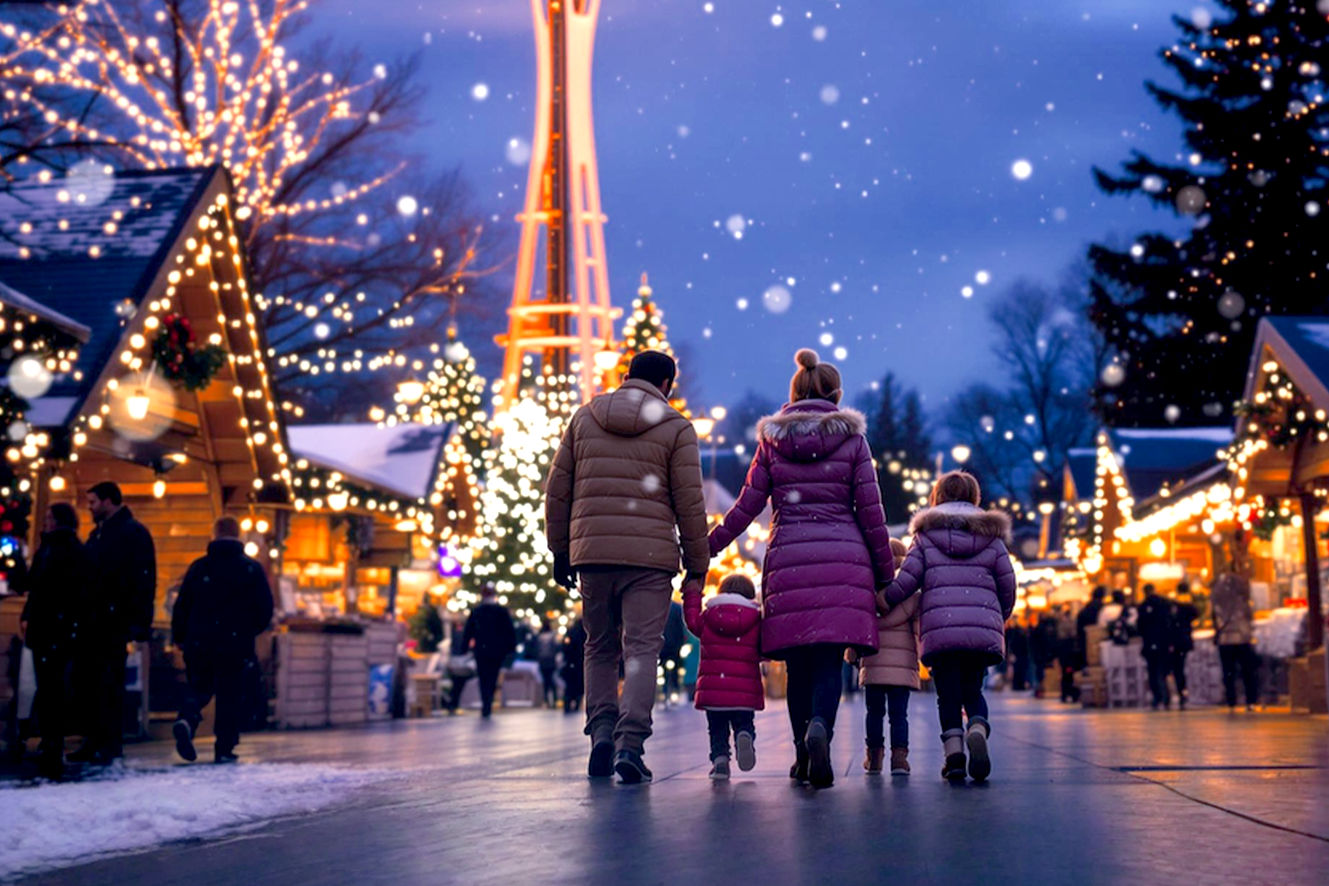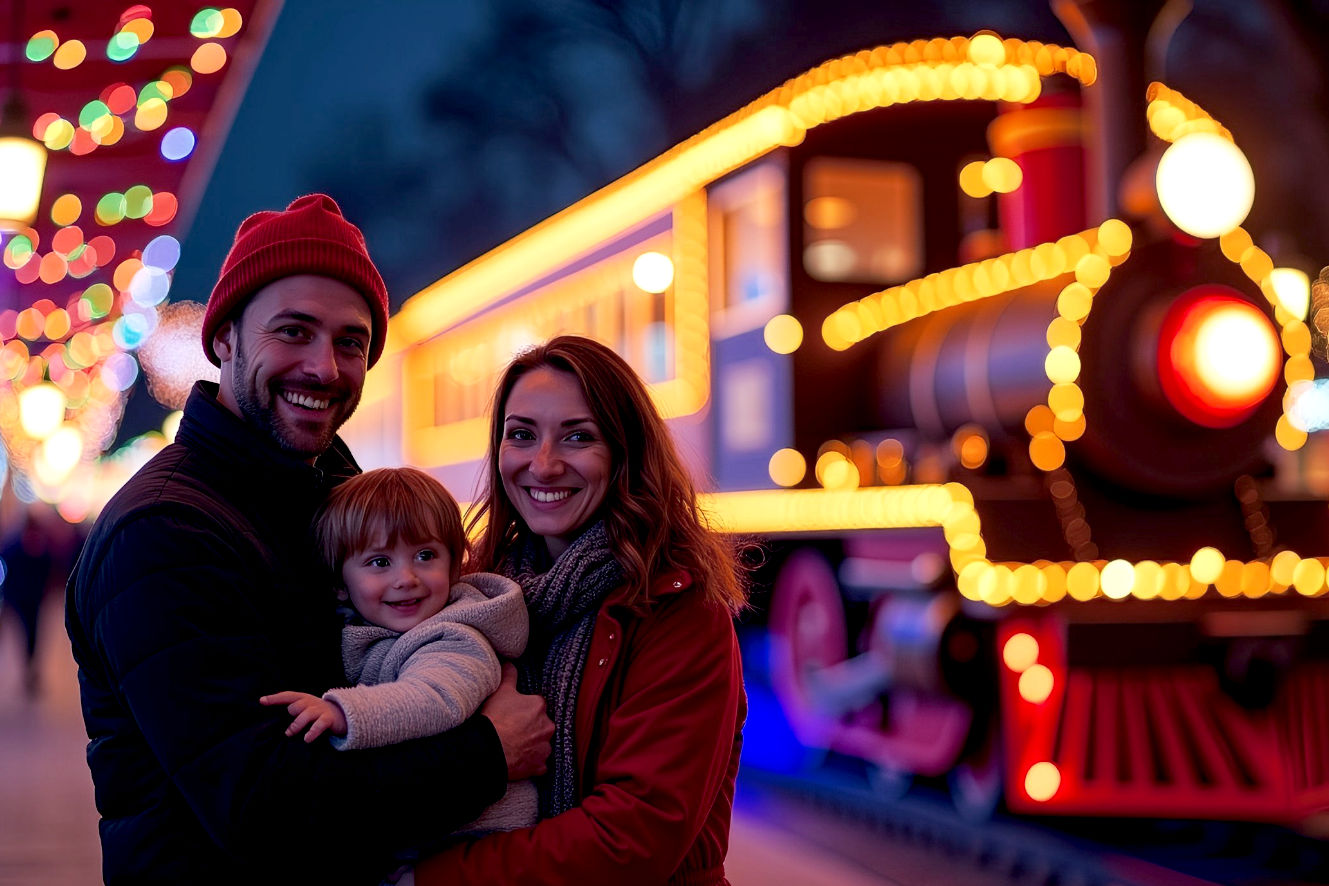This post may contain affiliate links. If you make a purchase through these links, we may earn a commission at no additional cost to you.
When it comes to Christmas Eve, few traditions are as universally cherished as the simple, yet profound act of piling into the car to drive through neighborhoods in search of the most spectacular light displays. This isn’t just a casual drive; for many, it’s a sacred ritual that marks the start of the holiday’s most magical night. It’s a time to witness the collective creativity and community spirit of a neighborhood, all while creating lasting memories with loved ones.
This guide goes beyond simple suggestions for your festive outing. We’ll explore the rich history that gives this tradition its unique depth, the surprising engineering behind the most dazzling displays, and the practical tips you need to make your Christmas Eve light tour an unforgettable experience.
An Illuminated Tradition: The Historical and Cultural Origins of Christmas Lights
The Christmas lights we see today are a far cry from their humble beginnings. To truly appreciate the scale and artistry of a modern display, it helps to understand the historical journey that brought us from fire-prone candles to the dazzling LED pixel shows of today. This evolution is a story of innovation, risk, and a shared desire to capture the magic of the holiday.
From German Trees to American Homes: A History of Illumination
The tradition of lighting Christmas trees began in Germany in the 17th century. Families would affix small, wax candles to the branches of evergreen trees as a symbol of Christ as the “Light of the World.” This practice, however, was incredibly dangerous. With dry tree needles and open flames in the living room, the risk of a house fire was a constant and terrifying reality. People often kept buckets of water nearby and lit the candles only for short, supervised periods, emphasizing the precious and fleeting nature of the holiday’s glow.
The introduction of electric lights marked a critical turning point. In 1880, Thomas Edison, the inventor of the light bulb, used strands of electric lights to decorate his laboratory for the holidays, providing one of the earliest examples of electric Christmas lights. But it was his business partner, Edward H. Johnson, who brought the idea into the domestic sphere in 1882. Johnson was the first person to decorate a Christmas tree with electric lights in his New York City home. He hand-wired 80 small, red, white, and blue light bulbs and wrapped them around the tree. This display, while a marvel of the time, was expensive and a logistical challenge; a generator had to be used, and the technology was not yet a consumer product. For several years, Christmas lights were a luxury reserved for the very wealthy or those with close ties to the electrical industry.
The widespread availability of electric Christmas lights began in the early 20th century, largely thanks to companies like General Electric (GE). The company began to offer pre-wired light strands, which were a game-changer. This innovation eliminated the need for home wiring and significantly reduced the fire risk, making the tradition much more accessible and safer for the average family. By the 1920s, GE was mass-producing and marketing light strings, and the glowing tree became an essential part of the American Christmas experience. This was the moment when the tradition began its slow march from an indoor ritual to an outdoor spectacle.
The Rise of the Outdoor Display and Community Spirit
The shift from indoor trees to elaborate outdoor displays gained significant momentum in the post-World War II era. With the advent of more affordable electricity and a burgeoning consumer culture, families began to extend their holiday decorations to the exterior of their homes. This wasn’t just about personal aesthetics; it was a deeply social and communal act.
The outdoor display quickly evolved into a friendly neighborhood competition. Families would try to outdo one another with more lights, more elaborate scenes, and more impressive displays. This friendly rivalry fostered a unique kind of community spirit. People would take pride in their neighborhood’s decorations, and residents would often spend weeks, or even months, preparing their displays. This era gave rise to the now-iconic “Christmas House”—a home so covered in lights and decorations that it becomes a local destination, attracting visitors from all over town. These houses often feature elaborate inflatable characters, motorized figures, and thousands of twinkling lights, creating a truly spectacular sight.
The tradition became more than just a decorative choice; it was a powerful symbol of community cohesion and festive celebration. Driving through these neighborhoods became a way for people to share in that collective joy and witness the passion and effort of their neighbors.
The Art and Engineering of the Modern Christmas Light Display
The Christmas light tour of today offers a diverse range of experiences, from charming, homespun displays to highly engineered, technically complex spectacles. Understanding these different types of displays and the technology that powers them can give you a new appreciation for the hard work and creativity involved.
The Different Types of Holiday Light Displays
When you’re out on your Christmas Eve drive, you’ll likely encounter a few distinct styles of light displays, each with its own unique charm and character.
Neighborhood and DIY Displays
These are the most common and often the most heartwarming displays. They’re typically created by homeowners using store-bought lights, inflatables, and plastic lawn figures. The charm of these displays lies in their authenticity and personal touch. You’ll see strings of C7 or C9 bulbs draped along rooflines, icicle lights hanging from eaves, and animated deer grazing on lawns. The focus here is on creating a warm, inviting, and festive atmosphere for neighbors and passersby.
Synchronized Musical Shows
These are the showstoppers—the displays that stop traffic and draw crowds. A synchronized light show involves a meticulously choreographed sequence of lights that “dance” to music. These aren’t just flashing lights; they are precisely timed to the rhythm, tempo, and mood of the holiday songs. The lights can pulse, chase, fade, and create complex patterns in perfect sync with the music, creating a truly immersive sensory experience. We’ll delve deeper into the technology behind these marvels shortly.
Professional and Commercial Displays
These are large-scale, often ticketed events, like a “Winter Wonderland” at a local zoo, a botanical garden, or a city park. These displays are built by professional lighting designers and often feature millions of lights, custom-built structures, and immersive experiences like walk-through light tunnels. They are meticulously designed to create a specific narrative or theme and offer a highly polished, large-scale spectacle that often becomes a regional tourist attraction.
The Technology Behind the Magic: A Deep Dive
The leap from simple light strands to synchronized light shows is an engineering feat. To understand how these creators achieve their dazzling effects, we need to look at the technology they use.
Incandescent vs. LED: An Enduring Comparison
For decades, the standard was the incandescent light bulb. These bulbs generate light by heating a filament until it glows. While they produce a warm, classic glow, they have significant drawbacks: they consume a lot of electricity, generate heat, and are relatively fragile. A single broken or burned-out bulb in an old series-wired string could cause the entire strand to go dark.
Today, Light Emitting Diodes (LEDs) have become the industry standard. LEDs are semiconductor devices that produce light when a current passes through them. Their benefits are immense:
- Energy Efficiency: They use up to 90% less electricity than incandescent bulbs, which is a major factor for displays with tens of thousands of lights.
- Durability: They are made of plastic and are highly resistant to breaking.
- Longevity: LEDs can last for tens of thousands of hours, a lifespan far exceeding that of incandescent bulbs.
- Versatility: They come in a wide range of colors and are easily controllable, making them perfect for modern displays.
Smart Lights and Pixels: The Digital Canvas
The most advanced displays rely on a technology known as addressable RGB pixels. A single pixel is a small module containing a red, green, and blue LED, along with a tiny microchip. The “addressable” part means that each individual pixel has a unique numerical address, allowing a computer to control its color and brightness completely independently of all other pixels. Think of it like a digital painting: each pixel is a tiny brushstroke that can be precisely controlled. This is what allows for complex animations like falling snow, scrolling messages, or intricate color-changing patterns.
The control of these thousands of pixels is often managed by a system called DMX (Digital Multiplex) or, more commonly for hobbyists, dedicated pixel controllers. These hardware devices act as the brain of the operation, receiving signals from a computer and translating them into instructions for each individual light pixel, telling it exactly when to turn on, what color to be, and how bright to shine.
Synchronizing to Music: The Art of Choreography
The magic of a musical light show isn’t just about the hardware; it’s about the software and the painstaking work of the creator. The process involves a concept called sequencing. Using specialized software like xLights or Light-O-Rama, the creator “sequences” the lights to the music.
Here’s how it works in a simplified sense:
- Import the Music: The creator loads a holiday song into the sequencing software.
- Map the Display: They create a virtual representation of their physical light display, including every strand, every tree, and every pixel on their house.
- Choreograph the Lights: The creator then listens to the song, moment by moment, and uses the software to program what the lights will do. They might make the roofline lights flash to the beat of a drum, a string of pixels scroll up to a rising musical note, or the entire house explode in a cascade of color during a crescendo. This is a highly creative and time-consuming process that can take dozens or even hundreds of hours for a single song.
- Playback: Once the sequence is complete, the software saves the instructions. On Christmas Eve, a dedicated controller plays the music and sends the light instructions to the thousands of pixels, bringing the entire display to life.
Planning Your Ultimate Christmas Eve Light Tour
Now that you understand the history and technology behind the displays, it’s time to prepare for your own tour. A well-planned light tour is more than just a drive; it’s a curated experience that can be optimized for maximum enjoyment and festive cheer.
Finding the Best Local Displays: Your Guide to Discovery
Finding the best holiday lights requires a bit of research. While you can always just drive around and hope for the best, a little planning goes a long way in ensuring you see the most impressive displays without getting lost or stuck in traffic.
- Online Resources: Start your search with local online resources. Many cities and communities have dedicated websites or Facebook groups where people share the addresses of spectacular light displays. Local news stations often publish annual guides and maps to the most decorated homes in the area. Search for terms like “best Christmas lights near me” or “holiday light tours [Your City Name].”
- Word of Mouth: Don’t underestimate the power of local knowledge. Ask friends, family members, or coworkers for their recommendations. Locals often know about hidden gems or neighborhood spectacles that aren’t widely publicized online.
- Driving and Mapping: Once you have a list of addresses, use a mapping tool like Google Maps to plot your route. A smart approach is to group nearby displays together and plan a logical, circular route that minimizes backtracking. This is especially important for Christmas Eve, when traffic can be heavy. Use the app’s “street view” feature to get a sneak peek of the decorations and verify that the display is worth the detour.
Essential Practical Tips for an Enjoyable Tour
To make your Christmas Eve light tour comfortable, safe, and truly magical, consider these practical tips.
- Timing and Crowds: The hour right before or after sunset is a popular time for light tours, which means it’s often the most crowded. If you have the flexibility, consider going a little later in the evening, after the younger families have gone home. Weeknights are generally less busy than weekends.
- Comfort and Safety: Christmas Eve can be chilly, so make sure everyone in the car is dressed warmly. Bring blankets to snuggle up in and a thermos of hot cocoa or cider to keep everyone warm from the inside out. Don’t forget snacks! You don’t want to have to make an emergency stop when everyone is in a festive mood. When driving, be extra cautious. Slow down, especially in residential areas, and be mindful of pedestrians and other cars that may be stopped to admire the lights.
- Enhancing the Experience: The right atmosphere can turn a great light tour into an unforgettable one. Create a curated holiday playlist to listen to in the car, or tune into a local radio station that broadcasts synchronized music for the light shows. If you’re a passenger, bring a camera to snap photos of the most beautiful displays. You’ll want to remember the spectacular lights and the joyful faces of your loved ones.
The Broader Impact: Community, Economics, and the Future
Beyond the dazzling colors and festive cheer, the Christmas light tour has a significant impact that extends far beyond the drive itself. It’s an economic driver, a community anchor, and a platform for artistic expression that continues to evolve.
The Economic Ripple Effect: More Than Just Pretty Lights
While a personal light display is often a labor of love, the tradition as a whole creates a considerable economic ripple effect in local communities.
- Driving Local Business: When people leave their homes for a light tour, they often stop at gas stations, convenience stores, and local coffee shops. If the light tour is a well-known community tradition, it can draw visitors from neighboring towns, who may also stay for dinner or do some last-minute holiday shopping. This influx of visitors provides a valuable end-of-year boost to local businesses that need it most.
- Seasonal Industries: A thriving light tour culture creates seasonal employment opportunities. Professional decorators and landscaping companies that offer holiday lighting services see a massive surge in business. This also extends to the people who build and operate synchronized shows, as they may sell plans or kits to other enthusiasts. The market for holiday lighting equipment, from basic strands to advanced pixel controllers, also benefits immensely.
A Community Anchor and a New Form of Storytelling
The act of decorating a home with lights is a powerful form of public art. It turns a private residence into a public spectacle, fostering a sense of shared experience and pride.
- Fostering Community: The light tour is a tradition that brings generations of families together, creating shared memories and bonding experiences. It’s also a powerful symbol of community cohesion. When a neighborhood collectively commits to decorating, it creates a palpable sense of unity and shared celebration. The friendly competition to have the “best lights” often leads to a more beautiful and festive street for everyone to enjoy.
- The Art of Light: For the creators of the most elaborate synchronized light shows, the display is a new form of storytelling. They use light as a medium to convey a narrative, evoke emotion, and tell a story through choreography and music. These displays are not just decorations; they are a form of performance art that engages the entire community.
The Future of the Christmas Light Tour: Sustainability and Innovation
The tradition of the Christmas light tour is far from static. It’s a living tradition that continues to be shaped by technology, environmental consciousness, and creative innovation.
- Energy Efficiency: The move to LED lights has already made a huge impact, but the future will likely see even more energy-efficient and sustainable displays. The use of solar-powered lights, which are already available, will likely become more mainstream as the technology improves.
- Interactive Experiences: The next generation of light tours may involve more than just passive viewing. Imagine a light display that is controlled by a phone app, where visitors can vote on the next song or change the colors of the lights. The integration of augmented reality (AR) could also transform the experience, overlaying animated figures or text onto the physical light display through your smartphone camera.
- Broader Accessibility: As technology becomes more affordable and user-friendly, we can expect to see more creators experimenting with synchronized shows and pixel displays. The future of the Christmas light tour is likely to be even more diverse, creative, and technologically advanced, ensuring this cherished Christmas Eve tradition continues to shine brightly for generations to come.






